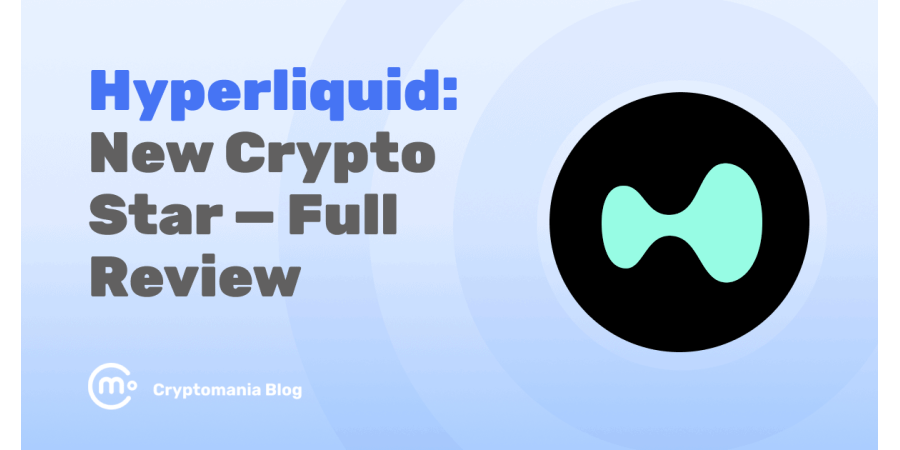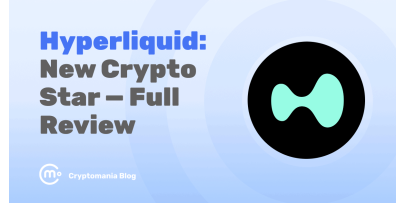Want free Hyperliquid tokens?
Now that you know what Hyperliquid is all about, check out our step-by-step guide to getting in on the airdrop:


If you’ve been watching the DeFi space lately, you’ve probably seen one name start coming up everywhere: Hyperliquid.
It’s fast. It’s permissionless. And unlike most decentralized exchanges, it feels like using a professional trading platform. Because it basically is.
Hyperliquid gives you access to high-speed, low-fee trading on a blockchain built specifically for performance — no MetaMask hassles, no gas fees, and no KYC barriers.
That alone would be enough to get people’s attention. But there’s more.
Hyperliquid launched without VC funding, airdropped a massive chunk of its token supply directly to users, and is now processing billions in daily volume. Its token, HYPE, has jumped over 10x since launch. And the platform keeps rolling out updates faster than most competitors can patch bugs.
In this review, you’ll learn what Hyperliquid actually is, who’s behind it, and what makes it stand out in a crowded market. We’ll break down the tokenomics, price action, app experience, wallet setup, airdrop history, and where the project might be heading next.
Let’s get started!
Hyperliquid is a decentralized crypto trading platform built on its own high-speed blockchain. It lets you trade assets like Bitcoin, Ethereum, and Solana using leverage, limit orders, and real-time charts. And you don’t need to sign up or verify your identity.
At first glance, it might feel like a centralized exchange. The interface is smooth. Trades happen instantly. You can place advanced orders and monitor positions just like you would on Binance or Bybit. But behind the scenes, it’s completely on-chain.
Most decentralized exchanges, like Uniswap or PancakeSwap, use automated market makers (AMMs) instead of order books relying on liquidity pools and pricing formulas to process trades. While this system works, it often leads to higher slippage and slower price updates.
Hyperliquid takes a different approach with a fully on-chain order book, recording every trade and price move directly on the blockchain. Built specifically for trading, it avoids the delays and gas fees that slow down many DeFi platforms.
There are no MetaMask pop-ups for every action. You don’t need to sign a dozen transactions just to get started. You can log in with just an email and connect your wallet when you’re ready.
In short, Hyperliquid combines the speed and power of centralized platforms with the transparency and security of DeFi. That’s what makes it “special”.
Hyperliquid wasn’t built by a big exchange or backed by venture capital. It came from a small team of highly technical builders who wanted to create a new kind of trading platform.
They wanted a platform one that was:
The project was started by Jeff Yan and a co-founder known online as Iliensinc. They met at Harvard, both with backgrounds in computer science and finance. Many of the early team members came from places like MIT, Caltech, and Citadel.
Before building Hyperliquid, Jeff was running a trading platform called Chameleon. After the collapse of FTX in 2022, he saw a huge gap in the market. People still wanted to trade, but they no longer trusted centralized exchanges with their money.
It was simple:
One of the most unique parts of Hyperliquid is how it launched:
This isn’t pure marketing. The team really did turn down outside investment to stay fully in control of the project.
That also meant they had no pressure to “go to market fast” or deliver returns to investors. Instead, they focused entirely on building a real product people would actually want to use.
Hyperliquid officially went live in 2024, starting with its own Layer-1 blockchain and a trading app on top. From day one, it supported spot and perpetual trading, high leverage, and fast deposits from other chains.
Since then, the team has continued shipping at a very fast pace, without outside interference.
There’s no shortage of crypto trading platforms out there. But Hyperliquid isn’t a typical decentralized exchange.
It takes everything that works about centralized platforms (e.g. speed, usability, reliability) and combines it with the trust and control of DeFi.
Here’s what sets it apart.
Most blockchains struggle under load. Ethereum is powerful, but gas fees spike fast. Layer-2s help, but they’re still limited by Ethereum’s base layer.
Hyperliquid does something different. It’s built on its own Layer-1 blockchain, using a custom consensus system called HyperBFT. This allows it to:
In practice, it feels fast because it is. You click, and the trade goes through. No waiting. No confirmation delays.
Unlike most DEXs, Hyperliquid doesn’t use AMMs (like Uniswap does). Instead, it uses a traditional-style order book, but with a unique approach: the entire thing lives on-chain.
This gives you:
For traders who want more control over execution, this is a huge upgrade from the curve-based pricing of typical DeFi platforms.
Gas fees and constant MetaMask pop-ups are a pain in DeFi. Hyperliquid removes both.
You don’t need to sign a wallet transaction for every action. Once your wallet is connected, you can:
It feels like a centralized exchange, but you never give up custody of your funds.
Hyperliquid’s design is clean and familiar. If you’ve used Binance, Bybit, or any major CEX, you’ll feel right at home.
But even if you’re new to trading, the interface is simple enough to pick up quickly. Everything is visible in one place:
You don’t need to juggle windows or hunt down hidden tabs. The platform was clearly designed by people who actually trade.
Bottom line: Hyperliquid gives you the speed and tools of a CEX, while keeping your trades and funds on-chain and under your control.
Hyperliquid crypto native token is called HYPE. It’s powering transactions, governance, and future protocol features.
But what really grabbed the crypto world’s attention was how the token launched, and how it’s been performing since.
Here’s what you need to know about Hyperliquid tokenomics.
There was no ICO, no presale, and no VC allocation. The majority of the token supply went directly to active users through an airdrop and is being distributed over time through community incentives.
The Hyperliquid coin has multiple functions on the platform:
| Category | Allocation |
| Season 1 Airdrop | ~31% |
| Future Community Rewards | ~38.9% |
| Core contributors | ~25% |
| Grants & Ecosystem | ~5% |
This approach gave the HYPE token strong community alignment from the start. Most of the supply went (or will go) to people who are actually using the platform.
HYPE launched at a starting price of around $3.90. Within months, it climbed rapidly. By June 2025, it hit an all-time high of $42.38. As of July 2025, it trades around $38, putting its market cap near $12.8 billion.
Quick timeline:
Hyperliquid price shows real demand. With trading volume in the billions and new users arriving daily, many see the token as both fuel for the platform and as a long-term investment opportunity.
Of course, like all crypto assets, it’s volatile. But so far, Hyperliquid has avoided many of the issues that drag down other tokens: insider unlocks, early sell-offs, or unclear utility.
The Hyperliquid app is where the trading is done. It runs directly in your browser, downloads and plugins are not needed. And it feels surprisingly close to a centralized exchange.
When you log in, everything’s in one place: charts, order books, open positions, order history, and leverage controls. You can toggle between spot and perpetuals, adjust position size, and place advanced orders like TWAP, stop-loss, and take-profit.
Main features:
The design is clean and intuitive. Once you connect via email or an EVM wallet, trading is quick and easy. The web interface adapts well to mobile browsers, though desktop offers the strongest user experience.
Hyperliquid supports most EVM-compatible wallets, so connecting is easy if you already use MetaMask, Rabby, or Coinbase Wallet.
You can also use native wallet options provided by Hyperliquid or supported third-party wallets like Gem Wallet.
There’s no forced custody. You always control your keys.
To deposit funds, you simply bridge assets from other chains (Ethereum, Arbitrum, Base, etc.) and then trade with those balances directly. Your HYPE stays in your wallet, and the app reads those balances in real time.
For storing HYPE, there are two main options:
Either way, you’re in full control. No centralized custody, no account approvals.
Hyperliquid launched its first major airdrop, known as the Genesis Event, on November 29, 2024. Around 31% of the HYPE supply (roughly 310 million tokens) was distributed to nearly 94,000 users.
Some received tens of thousands of tokens, with the average airdrop size coming in just under 3,000 HYPE.
There was no presale and no private round. The airdrop was designed to reward real users based on trading activity during the Genesis period. Within the first 48 hours, Hyperliquid saw a major user surge and daily trading volume spiked to nearly $2 billion.
Hyperliquid is now running a second airdrop campaign, structured more like a long-term points system. To be clear, there’s no official confirmation of a Hyperliquid airdrop season 2, but the community is treating it like a second season due to point emissions.
Instead of focusing only on past trades (i.e. volume), Season 2 rewards users for interacting with the broader ecosystem.
Ways to earn points include:
Points are calculated weekly and tied to on-chain activity. About 42% of the total HYPE supply is reserved for current and future community rewards.
The goal is simple: incentivize real usage and long-term participation.
You don’t need massive capital to qualify. Just staying active within the ecosystem, trading, staking, and using dApps can earn you a share of the rewards. And because it’s still early, engaged users have a head start.
Hyperliquid has moved fast since launch. And it isn’t slowing down.
In early 2025, the team rolled out HyperEVM, a major upgrade that lets developers deploy Ethereum-style smart contracts directly on the Hyperliquid blockchain. This opens the door for DeFi apps, stablecoins, lending protocols, and other on-chain tools to be built natively within its ecosystem.
There’s also growing support for copy trading vaults, permissionless liquidity pools, and synthetic assets. The goal is to turn Hyperliquid from just a trading platform into a full-stack financial layer.
What’s working in its favor:
But there are still real risks:
Still, if the team continues to ship and attract developers to HyperEVM, Hyperliquid could grow far beyond its current niche.
Hyperliquid is a full trading platform, built from scratch to deliver speed, usability, and transparency. Unlike a typical DEX, it doesn’t have the typical tradeoffs of DeFi.
You don’t need to trust an exchange, you don’t need to fight gas fees, you don’t even need to sign a wallet transaction every time you trade. And thanks to its early airdrops, a large portion of the HYPE token supply is already in the hands of real users, and not insiders.
Is it worth using?
If you want fast, no-KYC trading with real tools and low friction, yes. Hyperliquid is one of the best options out there right now.
Is it worth investing in?
That depends on your risk profile. HYPE has already seen massive gains, and the platform’s fundamentals are strong. But it’s still early, and the project will need to keep growing its user base and developer ecosystem to stay ahead.
For now, Hyperliquid is one of the most promising DeFi projects to watch, and a serious contender in the future of on-chain trading. But as we’ve seen countless times, “promising” and “huge potential” doesn’t always amount to something great in the end.